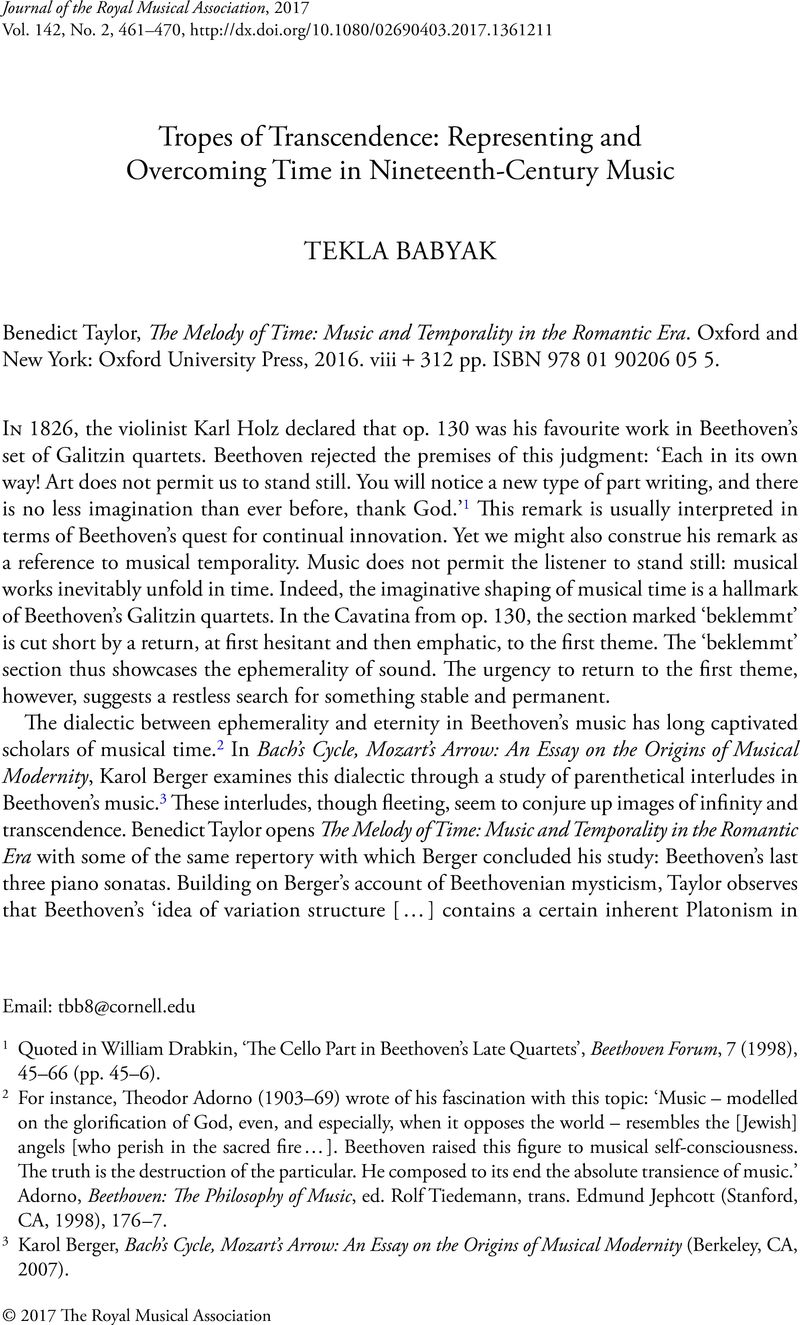No CrossRef data available.
Published online by Cambridge University Press: 01 January 2020

1 Quoted in William Drabkin, ‘The Cello Part in Beethoven's Late Quartets’, Beethoven Forum, 7 (1998), 45–66 (pp. 45–6).
2 For instance, Theodor Adorno (1903–69) wrote of his fascination with this topic: ‘Music – modelled on the glorification of God, even, and especially, when it opposes the world – resembles the [Jewish] angels [who perish in the sacred fire …]. Beethoven raised this figure to musical self-consciousness. The truth is the destruction of the particular. He composed to its end the absolute transience of music.’ Adorno, Beethoven: The Philosophy of Music, ed. Rolf Tiedemann, trans. Edmund Jephcott (Stanford, CA, 1998), 176–7.
3 Karol Berger, Bach's Cycle, Mozart's Arrow: An Essay on the Origins of Musical Modernity (Berkeley, CA, 2007).
4 Benedict Taylor, ‘Musical History and Self-Consciousness in Mendelssohn's Octet, Op. 20’, Nineteenth-Century Music, 32 (2008–9), 131–59; rev. and repr. as Mendelssohn, Time and Memory: The Romantic Conception of Cyclic Form (Cambridge, 2011), Chapter 2 (‘Musical History and Self-Consciousness: The Octet, Op. 20’), 52–102.
5 The key text in this regard is Richard Taruskin, Defining Russia Musically: Historical and Hermeneutical Essays (Princeton, NJ, 1997).
6 For a discussion of Elgar's engagement with imperialist discourses, see Corissa Gould, ‘“An Inoffensive Thing”: Edward Elgar, The Crown of India and Empire’, Music and Orientalism in the British Empire, 1780s–1940s: Portrayal of the East, ed. Martin Clayton and Bennett Zon (Farnham, 2007), 147–64.
7 This love of melody is one of the reasons why Hegel and Schopenhauer both enjoyed Italian opera. See Nicholas Mathew, ‘The Tangled Woof’, Journal of the Royal Musical Association, 134 (2009), 133–47 (p. 140).
8 On the formation of the canon during the nineteenth century, see William Weber, ‘The History of Musical Canon’, Rethinking Music, ed. Nicholas Cook and Mark Everist (Oxford and New York, 2001), 336–55 (p. 341).
9 In much of his other work, such as his earlier book Mendelssohn, Time and Memory, Taylor actually does address questions of historical consciousness in a philosophically sophisticated manner. It is thus all the more disappointing that he does not bring these insights to bear on his analyses in The Melody of Time.
10 Michael Puri, Ravel the Decadent: Memory, Sublimation, and Desire (Oxford and New York, 2012), 24.
11 James Hepokoski and Warren Darcy have shown that the genre of the minuet was predominantly associated with eighteenth-century court culture: ‘In the eighteenth century the minuet movement is the one most saturated with an “obligatory” social connotation. This centers around the social norms of (“old-world”) aristocratic society.’ Hepokoski and Darcy, Elements of Sonata Theory: Norms, Types, and Deformations in the Late Eighteenth-Century Sonata (Oxford and New York, 2006), 331.
12 Schubert had great difficulty earning a steady income as a composer, and may well have longed for the period in which a composer could usually secure a stable position as a court musician.
13 Melanie Lowe observes that ‘a minor-mode minuet is expressively marked before any other topical elements enter the field. Not only is every surviving dance minuet proper by Haydn and Mozart, with one exception (Haydn, Hob. IX:16, No. 18), in the major mode, but those minuets in the few minor-mode “public” symphonies of the late eighteenth century are almost always presented in the tonic major.’ Lowe, Pleasure and Meaning in the Classical Symphony (Bloomington, IN, 2007), 123.
14 Christopher Reynolds, Wagner, Schumann, and the Lessons of Beethoven's Ninth (Berkeley, CA, 2015), 67–8.
15 Ibid., 77.
16 Ibid., 107–34.
17 Julian Johnson, Out of Time: Music and the Making of Modernity (Oxford and New York, 2015).
18 James Webster, ‘Between Enlightenment and Romanticism in Music History: “First Viennese Modernism” and the Delayed Nineteenth Century’, Nineteenth-Century Music, 25 (2001–2), 108-26; Richard Taruskin, The Oxford History of Western Music, 6 vols. (Oxford and New York, 2005), i: The Earliest Notations to the Sixteenth Century, 380–5 (‘An Important Side Issue: Periodization’) and ii: Music in the Seventeenth and Eighteenth Centuries, 646–8 (‘Classic or Romantic?’); David Wyn Jones, Music in Vienna: 1700, 1800, 1900 (Woodbridge, 2016), esp. pp. 2–4.
19 Charles Rosen, The Romantic Generation (Cambridge, MA, 1995).
20 Quoted in Abigail Carter, E. T. A. Hoffmann's Musical Aesthetics (Farnham, 2006), 177.